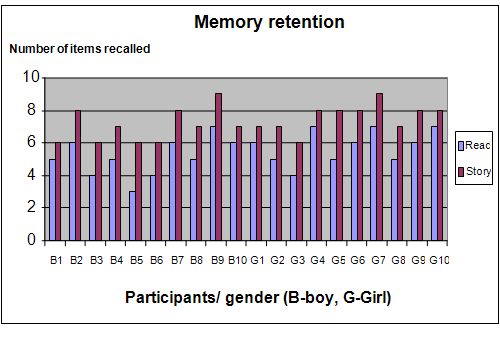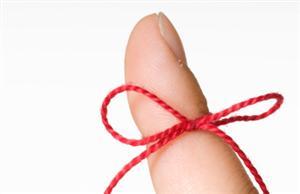| Complexity level: | 8 |
| Project cost ($): | 40 |
| Time required: | 1 hour to prepare, 2 hours for the science project experiment |
| Material availability: | Easily found |
| Safety concerns: | None |
Hypothesis
Linking a story to an item which needs to be memorized, helps to improve memory retention.
Overview
Memory improvement methods
Memory is the process of recalling information that has been earlier acquired by learning or through experience. Not everybody has a photographic memory (where people are able to immediately remember whatever they have seen or read). However, memory can be improved through practice, using some memory techniques, a proper diet and having enough sleep.
Numbers can be easily remembered by associating them with some figures that we are already familiar with. Examples are dates of birth or telephones numbers that we are already familiar with. These can be associated witha new number that we want to remember.
Similarly, certain things or items to be remembered can be converted into a story. The more hilarious or unusual the story, the more easy it is to remember. The story can also be visualized as a picture in our mind in order to enhance the memory. Some people convert the things to be remembered into a simple song in order to help improve their memory.
Scientific Terms
Materials
The materials required for the science fair project experiment:
- 10 boys and 10 girls aged between 12 and 15 years.
- 10 flash cards each containing an animal name
- A story about 300 words long and containing 10 names of different animals
- A quiet room to conduct the test
- 40 blank sheets of paper
- 20 pencils
- A stop watch
- An assistant
Procedure
1. For this science fair project, the independent variable is the 10 animal names on the flash cards and the story containing 10 animal names. The dependent variable is the ability of the children to remember the names of the animals. This is determined by asking the children to write down the animal names that they can remember. The constants (control variables) are the time they are allocated to look at the words, the time given to write the names, the number of animals needed to be remember and the speed at which the story is read to the students.
2. The 20 students are brought into the room where the tests will be conducted. They are made to settle down and get familiar/comfortable in the room. The students are given an explanation regarding the 2 tests and what they are required to do.
3. The testing is started by showing the students the cards with the names of animals. Each card is shown to the students for only 10 seconds. The time is measured by the assistant using the stopwatch. After all the 10 cards are shown, the students are given a 5 minute break. After the break, the students are given a piece of paper and a pencil to write down the names of the animals that appeared on the card. After 3 minutes, the papers are collected back.
4. The second test is performed by slowly reading a short story containing the names of 10 animals. After the story reading, they are again given a 5 minutes break and asked to write the names of the animals after the break. After the 3 minutes the papers are collected back.
5. The total number of correct animal names recalled by the students is recorded in the table given below.

Results
The results show that converting the items to be remembered into a story helps to retain the memory better than simply trying to memorize the names alone.
|
Test |
Number of words recalled by the boys for both tests |
|||||||||
|
B1 |
B2 |
B3 |
B4 |
B5 |
B6 |
B7 |
B8 |
B9 |
B10 |
|
|
Read |
5 |
6 |
4 |
5 |
3 |
4 |
6 |
5 |
7 |
6 |
|
Story |
6 |
8 |
6 |
7 |
6 |
6 |
8 |
7 |
9 |
7 |
|
Test |
Number of words recalled by the girls for both tests |
|||||||||
|
G1 |
G2 |
G3 |
G4 |
G5 |
G6 |
G7 |
G8 |
G9 |
G10 |
|
|
Read |
6 |
5 |
4 |
7 |
5 |
6 |
7 |
5 |
6 |
7 |
|
Story |
7 |
7 |
6 |
8 |
8 |
8 |
9 |
7 |
8 |
8 |
The chart below represents the results of our science project experiment.

Conclusion
The hypothesis that linking a story to an item to be memorized, helps to improve memory retention, is proven to be true. The association of a story activates several parts of the brain to help remember and recall the necessary information.
The process of memorizing is very important in helping us to recall past experiences or acquired knowledge. Students need to pack lots of information into their brains and to recall as much as possible during an examination. Clever memory retention techniques plus a good diet and exercise, help students cope.
Also consider
To improve the reliability and accuracy of our results, a larger sample of participants should be used.
This science fair project may be repeated, this time, by using a card with 10 words and a picture with 10 objects to compare which method helps retain memory better.
Modify the science project experiment, comparing the differences between participants who read their words silently and those who speak the words out loud.
References
How to improve your memory - http://www.wikihow.com/Improve-Your-Memory
Improving your memory - http://www.helpguide.org/life/improving_memory.htm
Improve your memory - http://personaldevelopment.suite101.com/article.cfm/improve-your-memory

